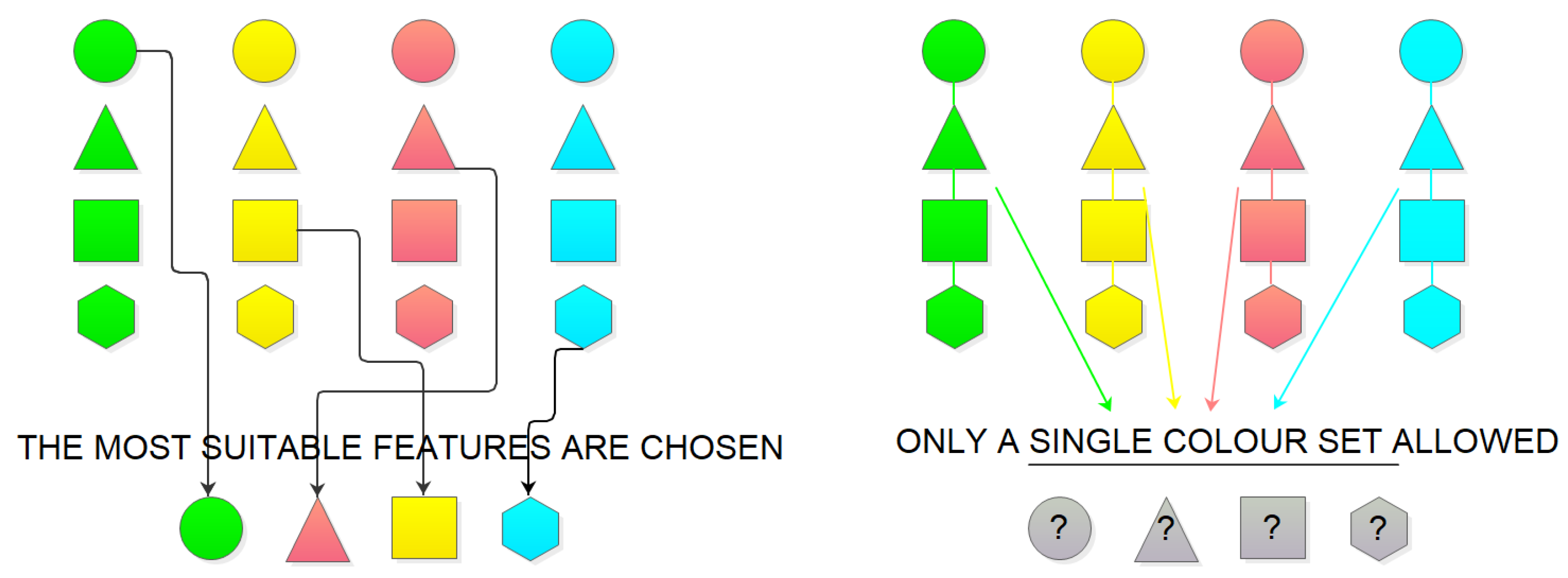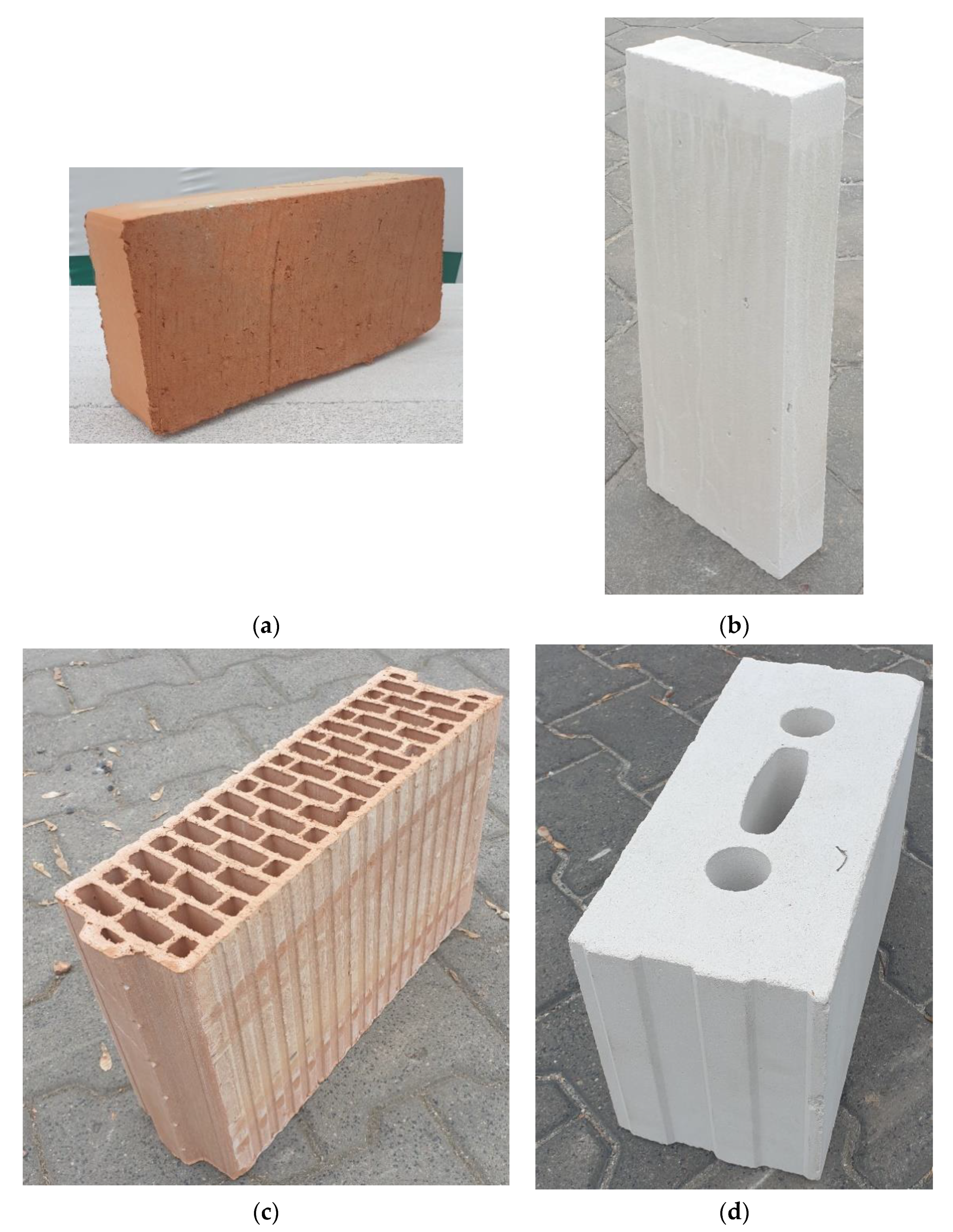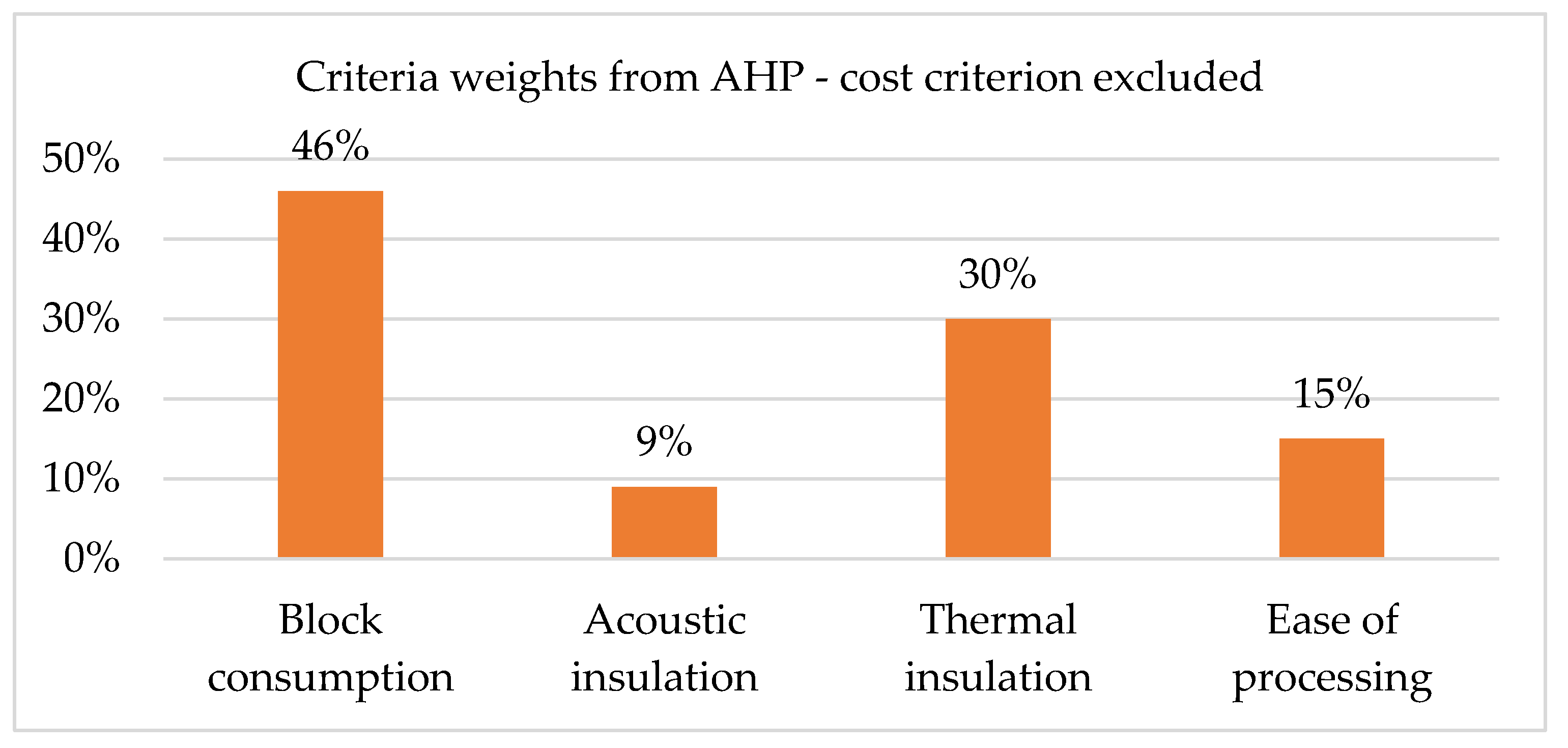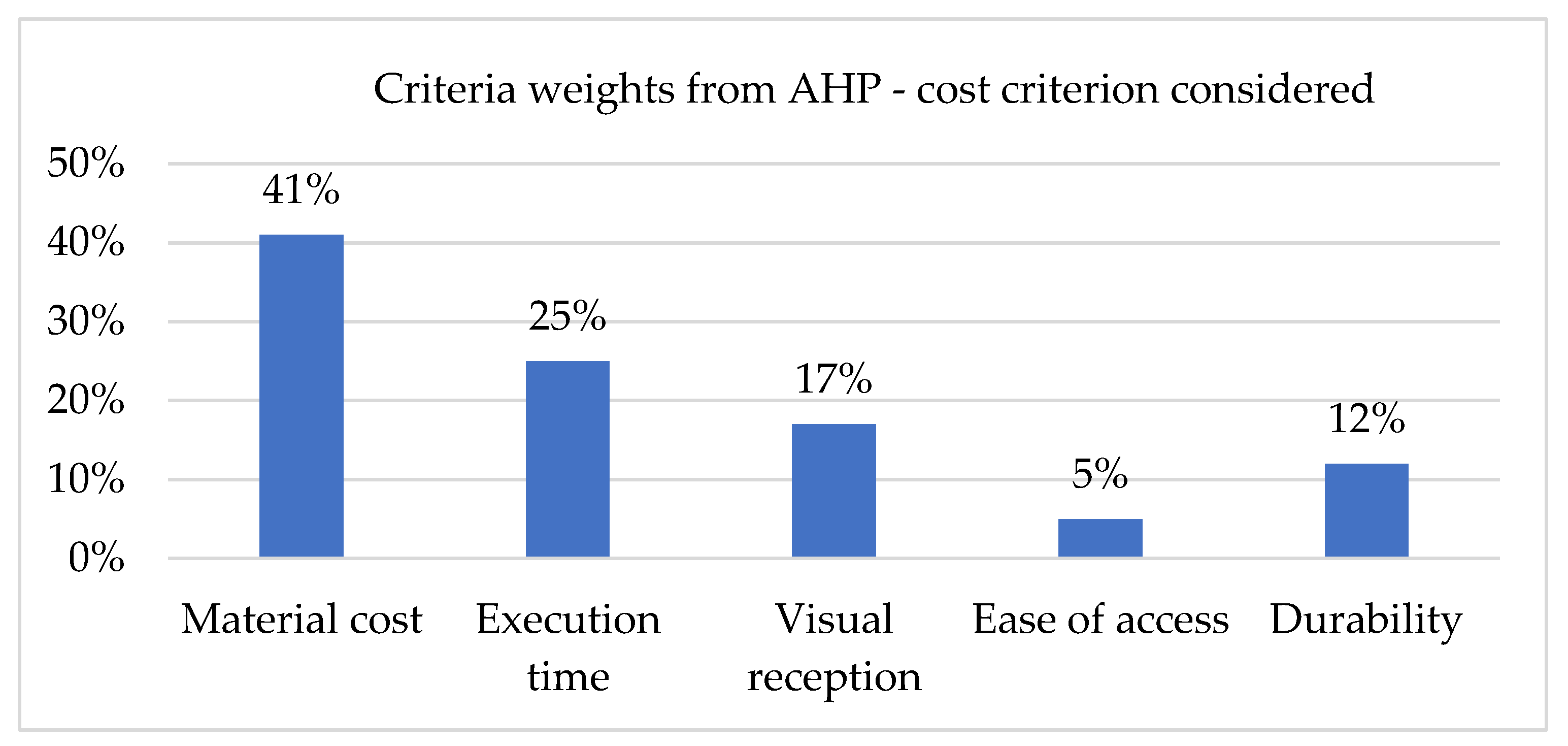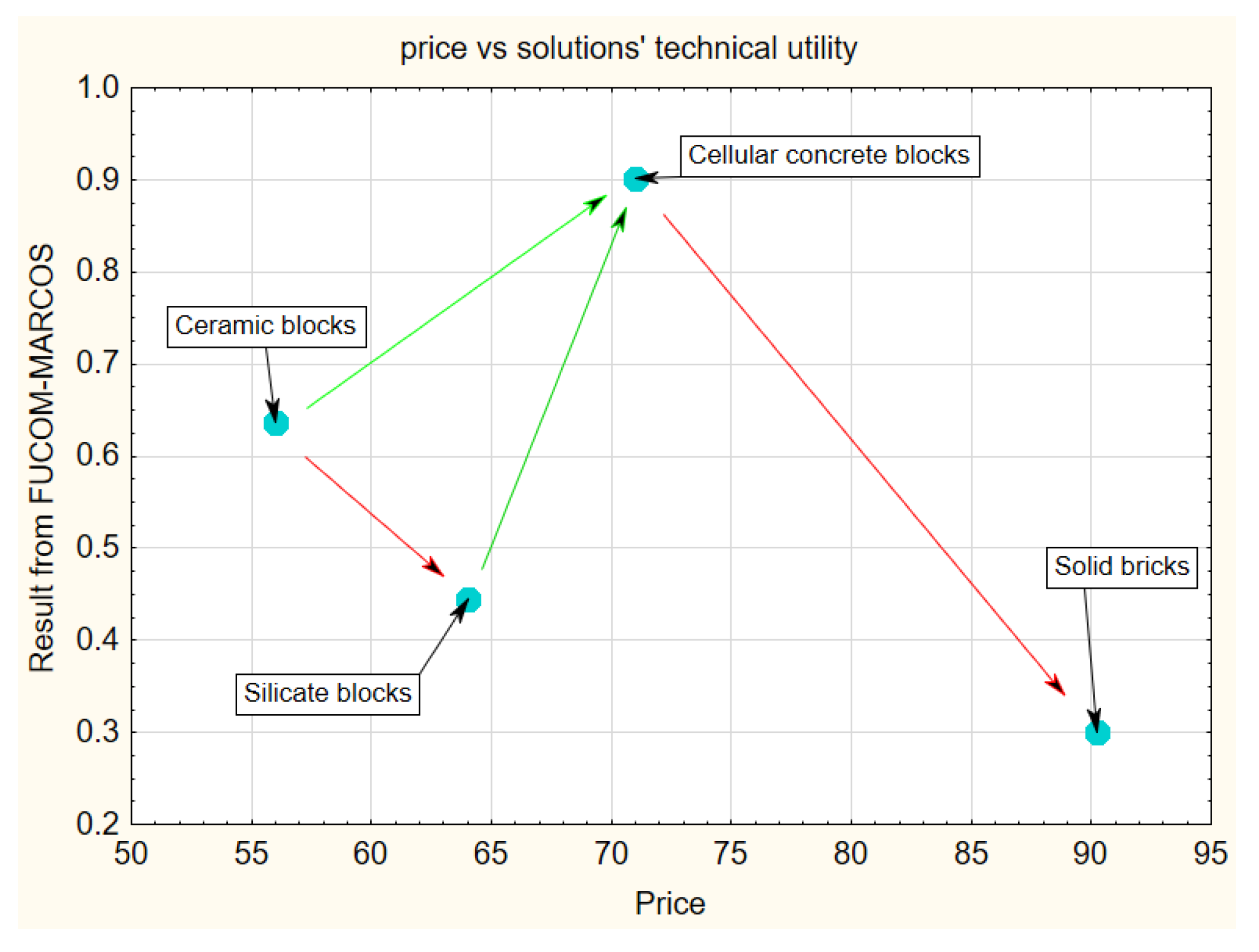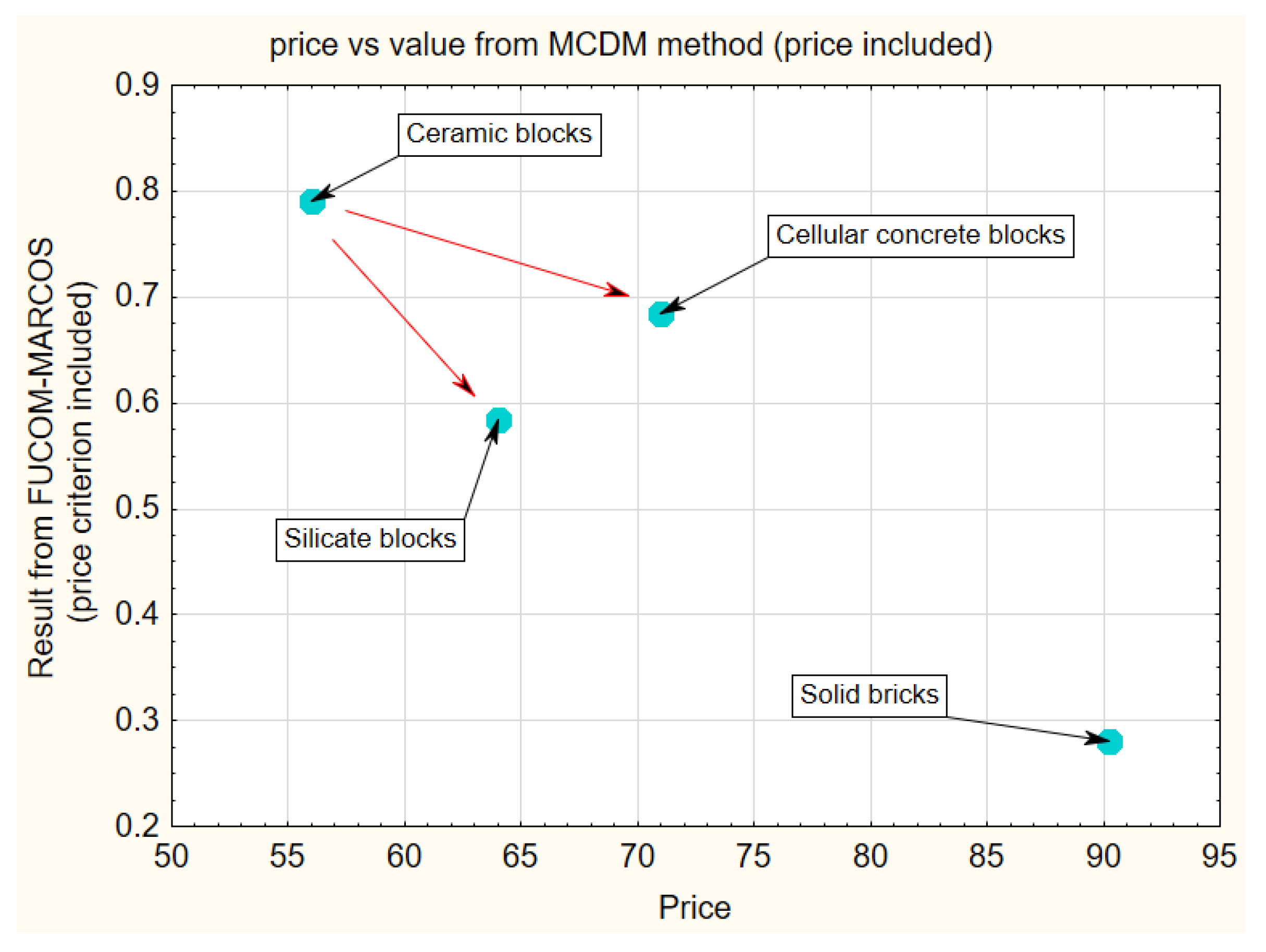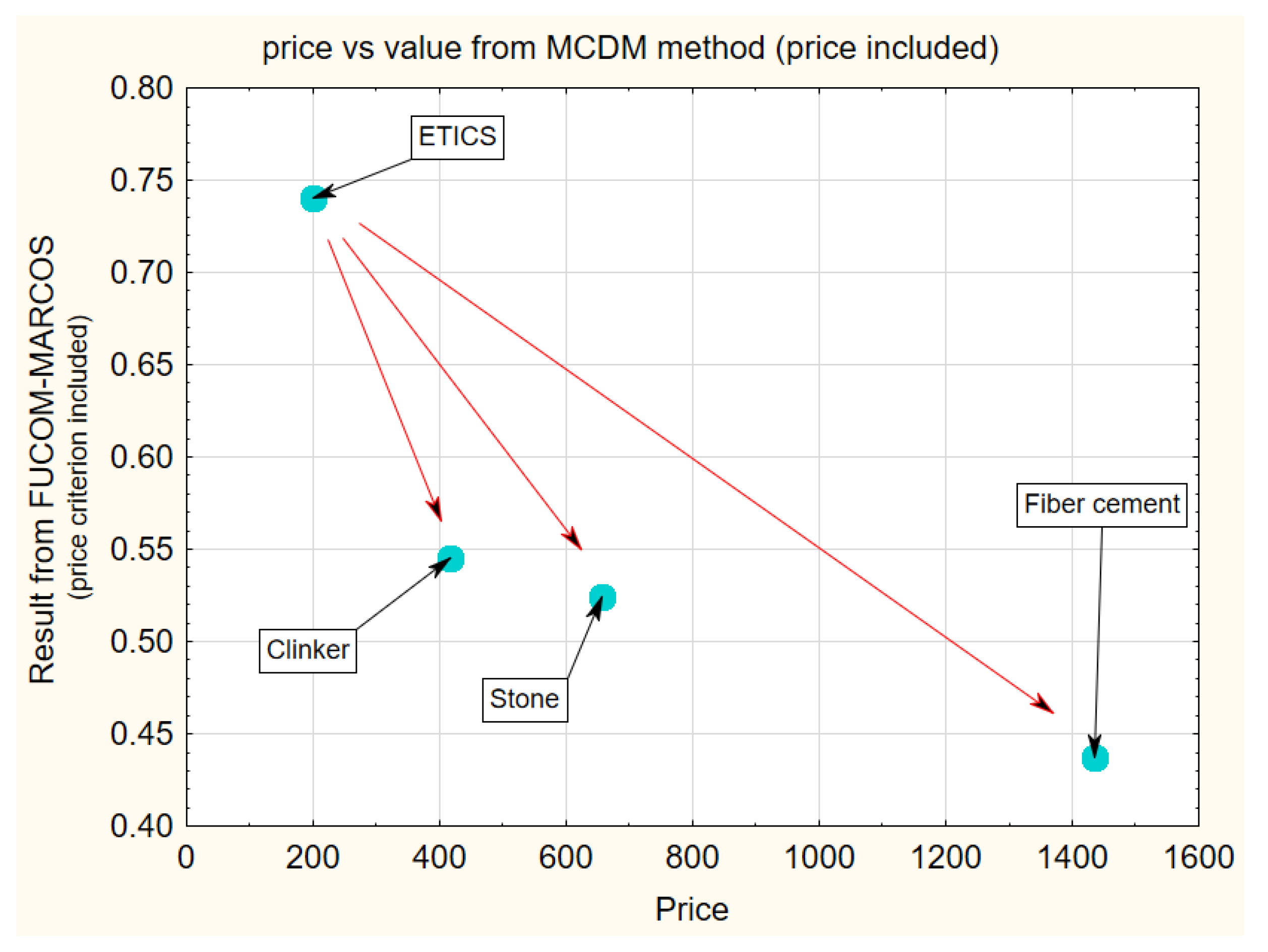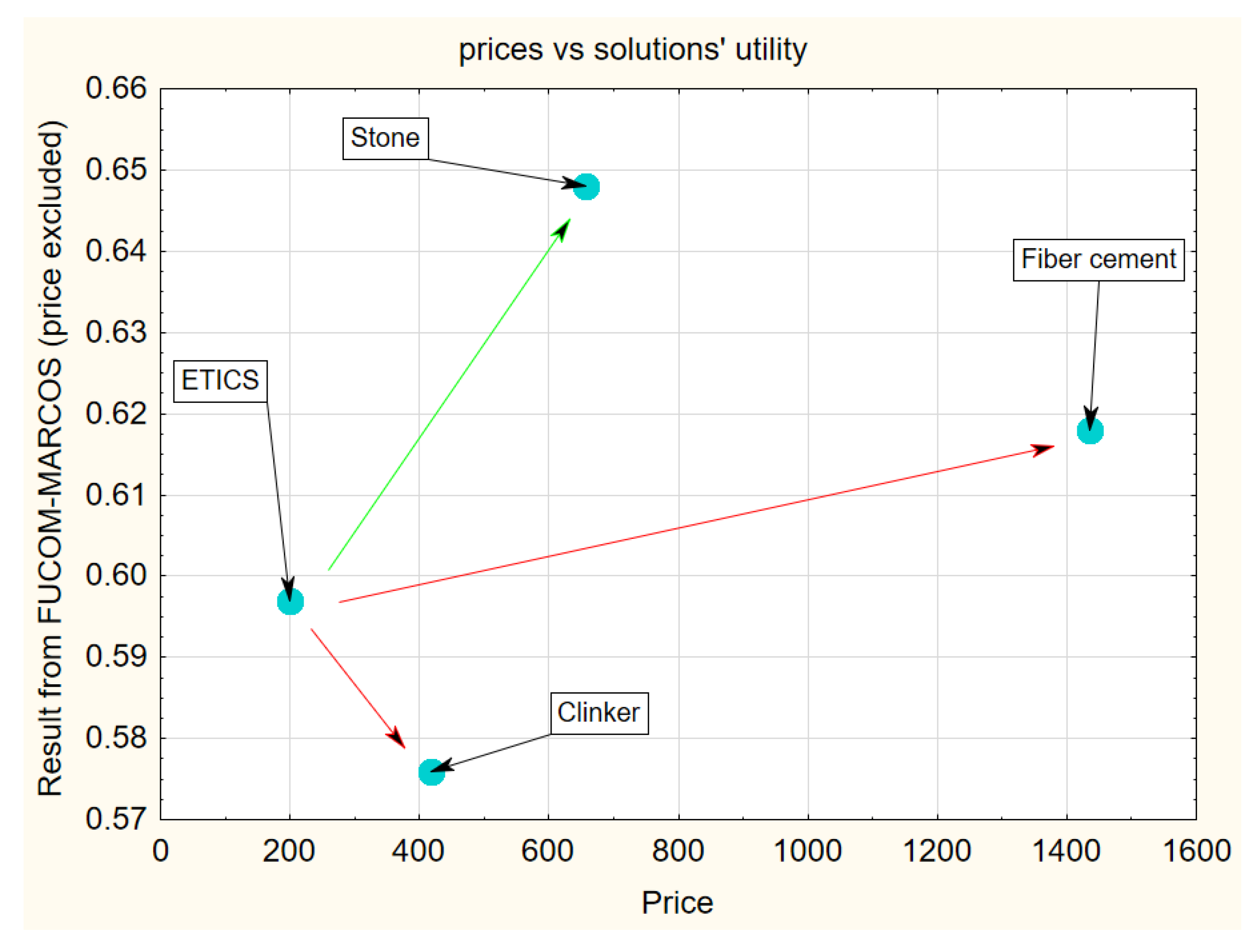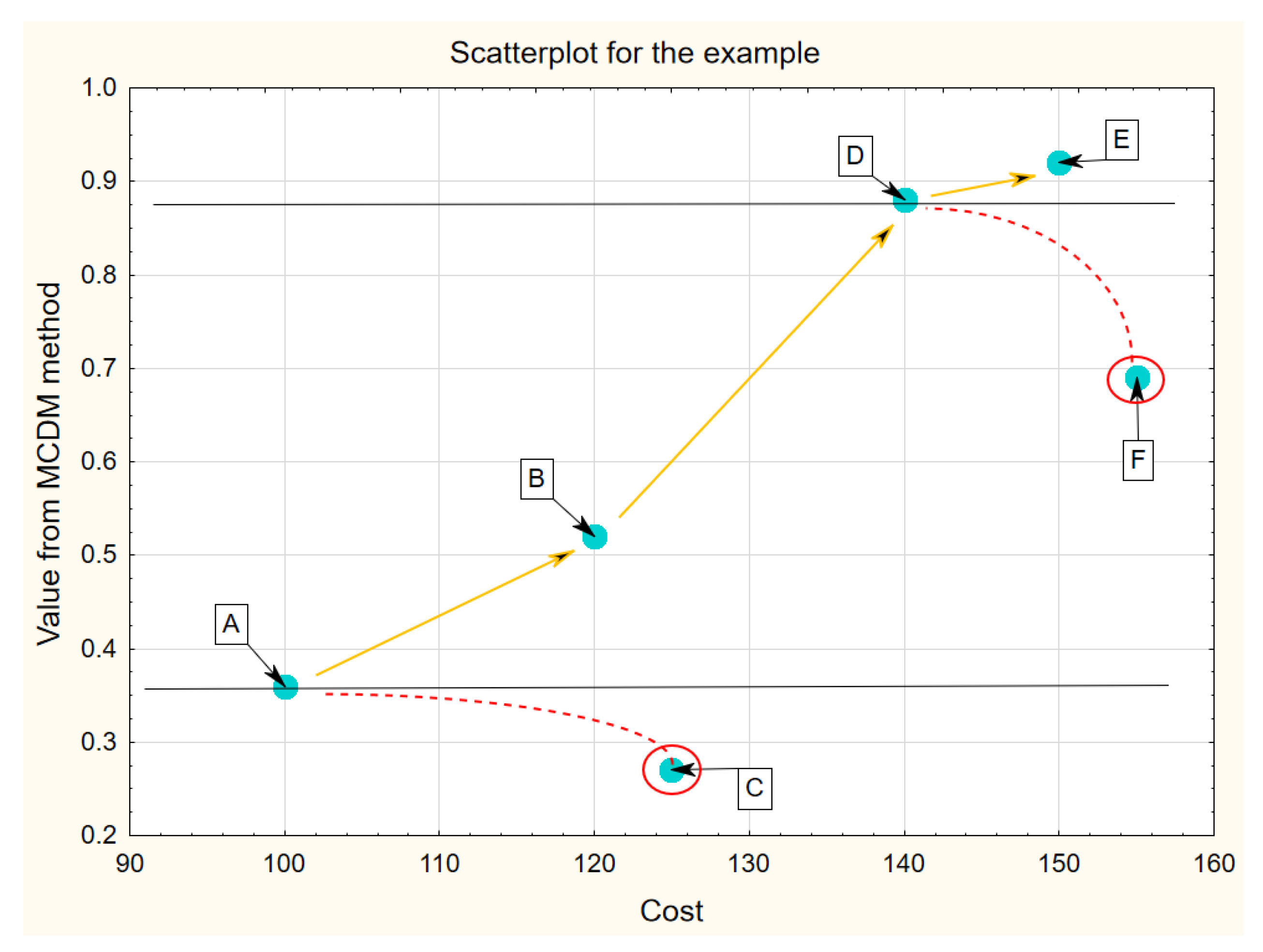1. Introduction
Multi-criteria decision making (MCDM) methods were invented for the cases where the choice of a solution has to be made and the solution has several properties inseparably connected to a certain solution. If it is possible to create the ideal solution, its components could be easily chosen and then incorporated. There are a lot of examples also in the construction industry for the choices where the solution can be only treated as a system with several inseparable properties. Cases where the set of properties match exactly the preferences of the decision-maker are rare. This lack of ideal matching of the properties and preferences means that if the choice is made—because it has to be made—some features are accepted in spite of the fact they are not of the highest level (defined by the needs, preferences of the decision-maker). The MCDM problem is illustrated in
Figure 1. The necessity of giving-up any value of a certain feature implies the comparisons to another solution, where another feature is not on the highest level. Is it reasonable, e.g., to give up 6 dB of sound insulation in favor of a 10% increase of thermal insulation of an external wall? It depends on the decision-maker’s preferences. It is not a rare case when even the decision-maker does not realize his preferences. Assessing them is a difficult task when there are several properties. It is even more difficult when the prices of analysed solutions are considered. The price is given for a solution, not separately for its properties. That is why the MCDM methods are invented. A significant part of the methods is invented in the previous century e.g., [
1,
2,
3], but their wide application and—sometimes—their imperfections push the scientist to invent the new MCDM methods or modify existing ones e.g., [
4,
5,
6,
7,
8].
Table 1 summarizes state-of-the-art on the variety of MCDM methods (concerning mainly the problems met in the construction industry and related ones as transport, logistics). They are also called MODM (multi-objective decision making as in [
9]) or MADM (multi-attribute decision making as in [
10,
11].
The fuzzy sets theory invented by [
52] is widely applied in solving MCDM problems (as e.g., in [
53,
54,
55,
56,
57,
58,
59]). The feature of transforming imprecise verbal expressions of assessment, into crisp numbers, which can be ordered, made the fuzzy sets theory popular in MCDM applications. It was used in 18 analysed articles. The MCDM analysis becomes more complex when uncertainty issues are considered [
4,
60]. The construction industry is a specific one. Huge amounts of capital are usually spent on a construction project and almost every structure is unique, even if the technologies and materials applied in the building processes are repeatable (except for materials which are prepared on construction sites [
61,
62]). Structures are erected in different places with different earth conditions, and once erected the serve then under different climate conditions. Therefore, a solution suitable for one structure can be completely unsuitable for the similar structure erected in the other place. Considering the aforementioned reasons, the decisions during for the construction process are of the highest importance, as their consequences are costly and long-lasting. To help the builders decide, MCDM methods are involved in working out the best decisions, i.e., decisions matching the best specific criteria applied to unique structures. Several examples can be found where multi-criteria decision-making serves for almost every stage of the construction processes. The application in the construction industry issues can be grouped and listed as for:
a party selection (supplier, subcontractor, etc.) [
22,
33,
36,
41,
54,
57,
64]
construction material selection [
42,
45,
56]
construction technology selection [
12,
20,
38,
50,
65]
machinery selection [
15,
47]
maintenance of the structures [
66,
67]
occupational risk issues [
13,
31]
project assessments [
11,
43,
51]
time and cost issues [
32,
73,
74]
The list of the applications of MCDM methods is not limited to the abovementioned subjects related to the construction industry. It should be emphasised that 37 analysed articles—almost 50% of articles illustrated with cases—use the cost as a criterion in MCDM. The importance of a single criterion and the problem of finding the set of criteria’ weights, reflecting the best preferences of the decision-maker are analysed as a core issue e.g., in [
7,
60,
75,
76,
77,
78]. Examples of sensitivity analysis in MCDM can also be found, e.g., in [
79].
The article aims to verify whether excluding the cost criterion from the MCDM analysis changes the result of the analysis. Moreover, the ranking of variants can be analysed at the end of MCDM analysis with consideration of the cost of each variant. This allows for a more conscious decision that considers the effectiveness issues of the variants to be chosen. It is achieved by selecting four MCDM methods (described in
Section 2.1) and applying them for different cases (presented in
Section 2.2). The results—rankings—are presented in
Section 3.
Section 4 contains the discussion of the results obtained for the cases when the cost criterion was included in MCDM methods, as well as, results where the cost criterion is excluded from MCDM analysis, but it is analysed jointly with rankings from MCDM methods. The structured, 6-stage method of analysis is proposed there. The term cost is often exchanged with the term price in the subsequent sections, as the price paid for the material or the system creates cost for the buyer (the decision-maker).
4. Discussion
The results from three methods, which include price criterion, indicate that ceramic blocks are the most favorable wall construction material. On the other hand, solid bricks are the least favorable. The ceramic blocks and cellular concrete blocks are ranked as 2nd or 3rd depending on the method used. Even though, the results are slightly inconsistent, for all three MCDM methods cost is the critical criterion, skewing the results (see
Table 4).
Removing the price criterion from the inputs to the MCDM methods results in a differently ordered ranking. Moreover, the rankings become consistent. The most favorable are cellular concrete blocks. The sequence of the rest of the materials is the same from all methods applied: 2nd—ceramic blocks, 3rd—silicate blocks, 4th—solid bricks. When block consumption, acoustic insulation, thermal insulation, and the ease of processing are considered the cellular concrete blocks are ranked the highest, indicating to be the most suitable solution from technical properties and technological perspectives. However, the other two solutions (ceramic blocks and silicate blocks) are cheaper than cellular concrete blocks (which are consistently ranked higher). There is a logic behind it as the construction industry is highly capital consuming. The structural wall price increase of 10%, considering the area of the walls of a thousand m2 may significantly influence the financial result of the decision-maker employer.
Let us present the result from the FUCOM-MARCOS method (with excluded the price criterion) together with the prices on the horizontal axis (
Figure 10).
As the ranks of the masonry wall solutions are the same, the general shape of
Figure 10 would be the same if it is prepared based on results from AHP and TOPSIS methods. This way of the results’ presentation is of great importance. The method points to cellular concrete blocks as the best solution (according to the decision maker’s preferences). Beginning the analysis from the cheapest solution, it is obvious that the choices of silicate blocks or solid bricks are irrational. They give much less of the technical utility (defined by the decision-maker) for much higher prices. The cellular concrete blocks (the highest utility) and ceramic blocks (the cheapest) trade-off is the only one that should be considered by the decision-maker.
Preparing a similar scatterplot for the case with price criterion included in the MCDM method (see
Figure 11) is possible, but it is not so informative and useful (as for the case where the price criterion is not considered in the MCDM method). Beginning the analysis from the cheapest and the best solution (pointed by the method)—ceramic blocks, the change to the other (2nd or 3rd) solution can be theoretically considered. However, for cellular concrete blocks (2nd position in the ranking) and silicate blocks (3rd), the price increase can be observed together with the loss of value (calculated through the MCDM method). This is misleading because of the influence of price on the position in the ranking (on the value got from the MCDM method). Solid bricks shouldn’t be considered at all according to the worst position in the ranking and the highest price.
In the second case—the choice of the facade cladding system—there are also qualitative criteria as durability (assessed with Delphi method), visual reception (assessed through questionnaire form in [
27]). Only the prices of the systems are the quantitative input to the MCDM methods. The results (with price criterion considered) can also be presented in the form of a scatterplot (see
Figure 12). All three methods ranked four types of facade cladding the same. When the price criterion is included, it dominates and the best system is the cheapest one (ETICS facade). The highest price is seven times higher than the lowest one. Regardless of the type of MCDM method applied, the method will be very price sensitive. The higher the price of the cladding system the lower the rank is assessed.
Figure 12 indicates that the more is paid for the facade system, the lower is its value for the decision-maker. This statement is questionable.
Figure 13 presents the results from the FUCOM-MARCOS method, where the price criterion is not considered.
Considering the cheapest solution (ETICS facade system), clinker cladding should be excluded, as its properties—according to the decision-maker preferences—are lower than ETICS, but the price is higher. The fiber-cement cladding provides insignificant gains in the value (defined by the decision-maker), but its price is 7 times higher than the ETICS price. It should be excluded from reasonable solutions. The only alternative to the ETICS is the stone facade. It is over three times more expensive (not seven times as fiber-cement panels), but provide the highest increase of the value recognized by the decision-maker. The AHP and TOPIS methods produced the same sequence of facade systems indicating the same results as presented in
Figure 13.
There is an extremely important conclusion, which was so far implicit: if the cost criterion is applied in MCDM analysis, it means that economic issues are important for the decision-maker. The higher the cost of the variant, the lower the decision maker’s willingness to choose the variant. The cost increase may lower the efficiency or capabilities of the entity, the decision-maker acts for. This is the very important reason, to exclude the price criterion from MCDM methods, and to analyse the results achieved through them at the final stage considering the costs of variants. This procedure—described below—can be named MCDM-CCAF (multi-criteria decision making with cost criterion analysed at the final stage). It is proposed and strongly recommended to apply it for MCDM methods—where costs are one of the factors influencing the result—proceeding with the following procedure:
Stage 1: exclude the cost criterion from the set of criteria and calculate the ranking of variants with the MCDM method.
Stage 2: order the variants in cost ascending sequence, then prepare a scatterplot (
Figure 10 and
Figure 13 as examples).
Stage 3: start the analysis from the cheapest variant and exclude the variants of the lower value (from the MCDM method) than the cheapest.
Stage 4: make a decision based on the trade-off: choose the cheapest variant (it stops the procedure), or consider the variant providing higher value, but which is just a step more expensive.
Stage 5: if the more expensive variant is chosen, exclude from the analysis all variants providing the value lower than the variant being just analysed.
Stage 6: make a decision based on the trade-off: choose the presently analysed variant (it stops the procedure), or consider the variant providing higher value, but which is just a step more expensive (if exist; if not the procedure is stopped). Go to Stage 5.
This 6-stages procedure (CCAF) has the following easy noticeable advantages:
It protects the decision-maker from choosing the variant which has a lower value, but its cost is higher
Every next variant, if considered, brings an increase of the value
Economic analysis (based on the cost of the analysed variant) can be made on each intermediate stage (not only on the final one)
As a result of these economic analyses, the decision-maker can stop the procedure at every analysed variant, i.e., he can choose the variant providing fair technical properties paying a fair price for it. The choice of technically the best solution is not compulsory.
For a clear explanation another example is prepared (see
Table 13).
The proposed 6-stages CCAF procedure is illustrated in
Figure 14.
Initially, the cheapest variant (A) is chosen. As the variant C is assessed lower, it is excluded from the available variants. The closest step up with the price is now the variant B. Choosing If it is chosen (instead of A) as a variant bringing more of the value than A, A is excluded from the available variants. Except for variant B, there are now also D, E, F available. Then the choice has to be done: staying with B (according to economic reasons) or considering D as more valuable and more expensive (just one step more expensive than B; for the same reason the choices of F or E are forbidden). If D is chosen, all less valuable variants (B and F) should be excluded from the set of available variants. Finally, the choice between D and E should be made. It is up to the decision-maker (depends on his price perception) which variant will be chosen: of the lower value and cheaper (D) or the variant providing the highest value and more expensive than D (i.e., E). The 6-stage CCAF procedure protects from choosing unreasonable variants C and F, as well as, allow considering economic issues while deciding if to choose the more valuable variants. It is not possible to present the cases of all possible mutual location of variants on the scatterplot, however, they were analysed. Applying the MCDM-CCAF procedure, the set of possible choices are Pareto-optimal i.e., for each chosen price the prosed variant is of the best value (value in terms of decision-maker preferences). The proposed MCDM-CAFF procedure can be presented as a flowchart (
Figure 15).
In the traditional approach, where the cost criterion serves as an input to the MCDM method (as in the 37 articles mentioned before), this kind of analysis is not possible. The technical, technological, and more intangible (as visual reception) preferences of the decision-maker are mixed with the economic preferences (accepted level of cost to be spent on a certain variant).
Other advantages of the proposed 6-stage method are:
The producers usually price their products based on the properties of the products, but also based on the competitors’ prices, the state of the market, etc. Accepting the price into MCDM analysis means the influence of the market issues on the prepared assessment. Considering the price after MCDM analysis (i.e., applying proposed CCAF), makes the choices more explainable. Features of the product are transformed into the ranking based on the decision maker’s preferences (through the MCDM method), and then, the decision-maker’s price sensitivity is matched to the market price of the products (stages 3 to 6).
In the traditional MCDM, the variant assessed as the 2nd (or with lower rank) is presented as a worse one (also because of its price). In economic decisions (as the decision based on cost is) the ratio: value (received) to cost (spent on it), is very important. The proposed method is based on this concept
All advantages of MCDM methods are kept, as MCDM is a part of the 6-stage method (jointly named as MCDM-CCAF).
Price changes (caused by market processes or achieved in negotiations) can be easily adjusted in the scatterplot (without the necessity of repeating MCDM analysis, as other than price criteria e.g., sound insulation or number of block per m2 are stable).
Disadvantages of MCDM-CCAF:
Higher analytical effort (if compared to a solely applied, pure MCDM method).
Only one cost criterion can be considered (if there are more, they should be combined into one).
5. Conclusions
Among the analysed articles there are 79 where multi-criteria decision-making methods are applied to construction industry problems. In nearly 50% of them (i.e., in 37) the costs of analysed variants serve as an input to MCDM methods. Considering cost as a criterion in evaluating the decision-maker’s preferences makes the result from the MCDM method cost-sensitive. The influence of technical, technological, and other—“intangible”—criteria is analysed then together with the influence of cost on the final ranking. In all these 37 analysed articles the cost criterion is considered. It is proposed to exclude the cost from the set of criteria (i.e., from the MCDM analysis input) and consider it when the result from the MCDM method is already calculated. Then, with the use of the proposed procedure (named MCDM-CCAF) variants are filtered. Only Pareto-optimal variants are left to the decision-maker, to choose. Based on the budget, the decision-maker chooses the acceptable price. There is only one variant assigned to each price, providing the maximum value (the value other than cost-based value, calculated through the MCDM method, according to the decision-maker preferences). Moreover, the process of choosing the variant (from the set of Pareto-optimal variants) is realized in the CCAF procedure step by step (see Stages 3 to 6 described in the discussion section). Each step shifts the focus to consider just one step up (in terms of cost) and allows the decision-maker to decide (at each price level) which variant is the most suitable.
It is strongly recommended to apply the proposed MCDM-CCAF method to the problems where the costs of the variants are important. There are numerous advantages of excluding the cost criterion from pure MCDM analysis. The most important advantages of the MCDM-CCAF method are as follows: versatility (it can be applied with any MCDM method), economic sensitivity (each Pareto-optimal variant provide the highest value, for the price chosen), easiness of application (finding the result from MCDM-CAFF is not more complicated than the complexity of applied MCDM method), time-saving (in case of price changes).
